Abstract
The activin/transforming growth factor-beta (TGF-beta) family of peptide growth factors plays a central role in the induction of mesoderm during early Xenopus embryogenesis. Immediate transcriptional responses to mesoderm-inducing signals have been described, but the signal transduction steps leading to these early responses are unknown. We describe here the first pre-transcriptional response to activin/TGF-beta mesoderm inducers in the early embryo. We have identified a cellular factor which binds to a 50 bp portion of the promoter for an activin/TGF-beta early response gene. This factor is activated within 4 min of treatment of embryonic prospective ectoderm with mesoderm-inducing factors, making it the earliest response to these factors described in early embryos. This factor can be activated throughout early cleavage and blastula stages, is activated by mesoderm inducers of the activin/TGF-beta superfamily but not the fibroblast growth factor (FGF) family, and does not appear to require an endogenous FGF signal for activation. Characterization of this factor provides a powerful tool for studying the early steps in the induction of mesoderm by members of the activin/TGF-beta superfamily.
Full text
PDF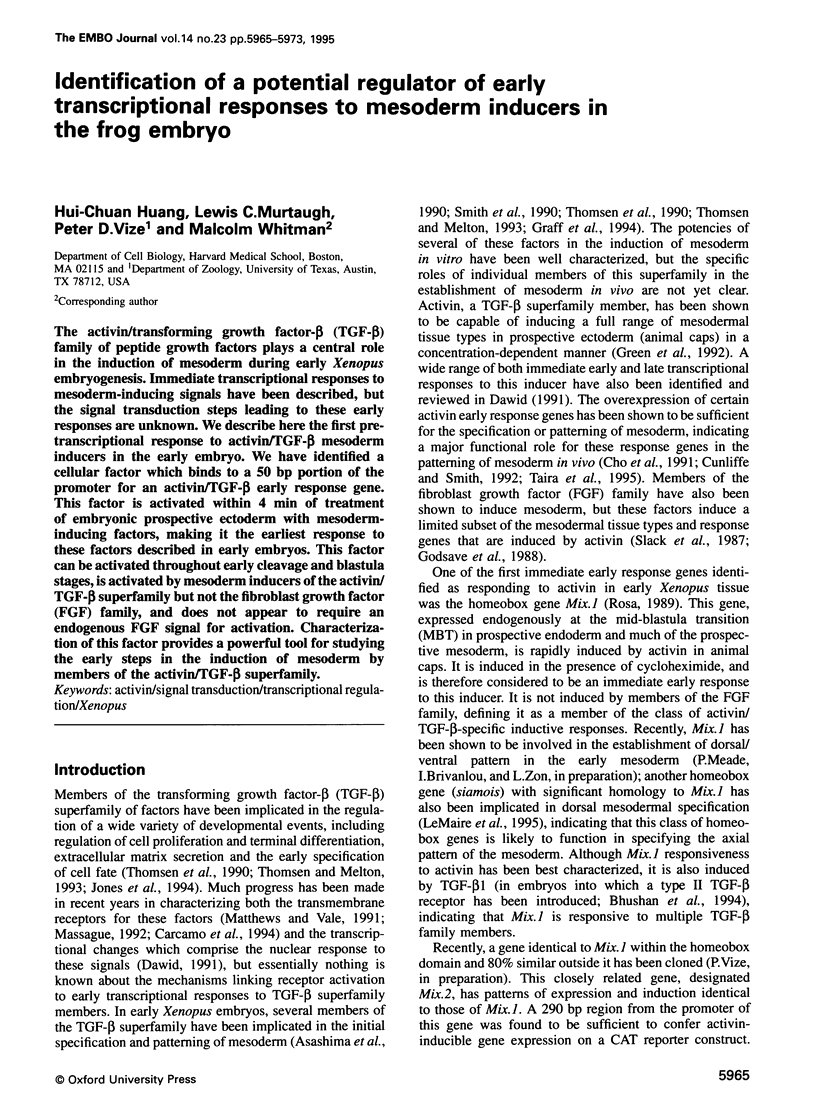
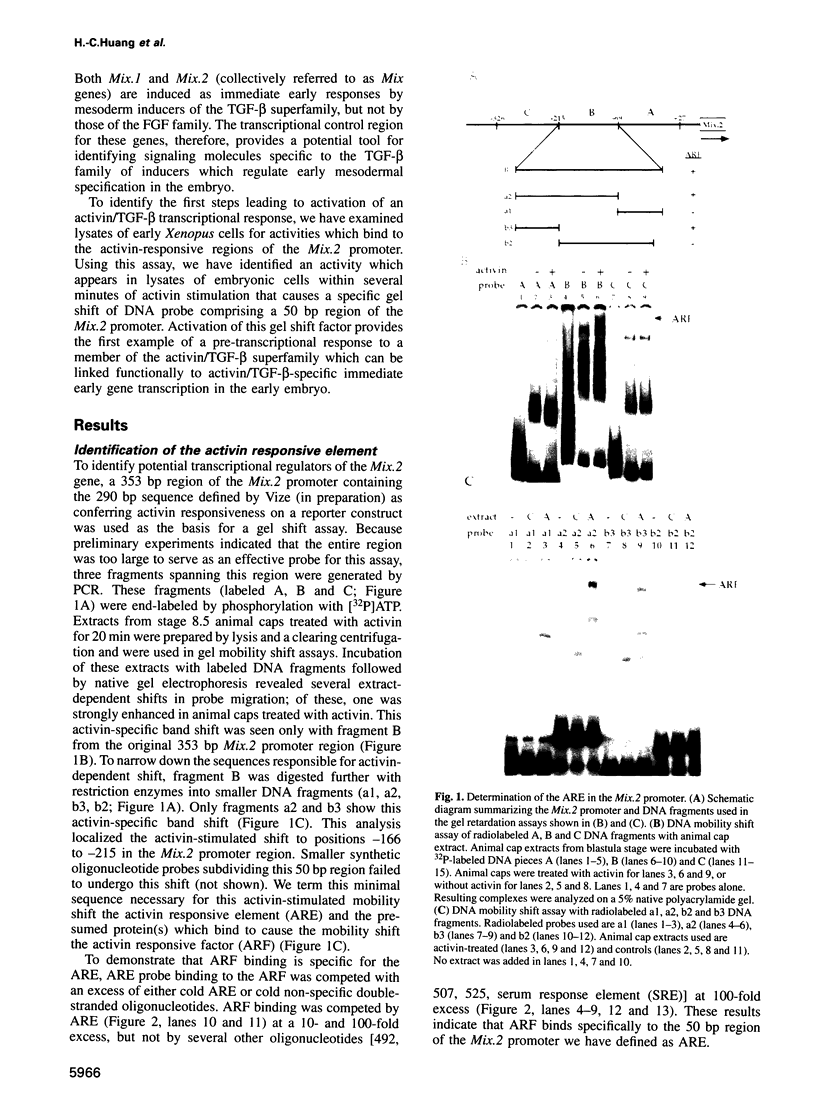
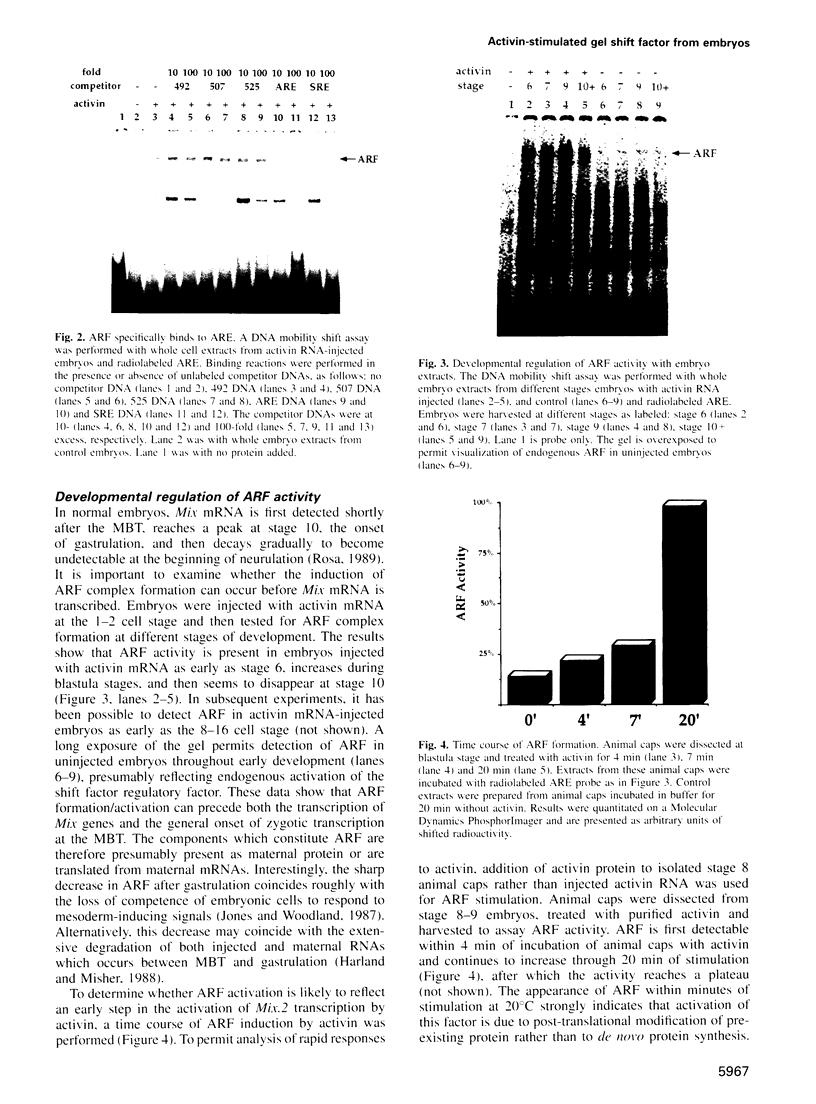
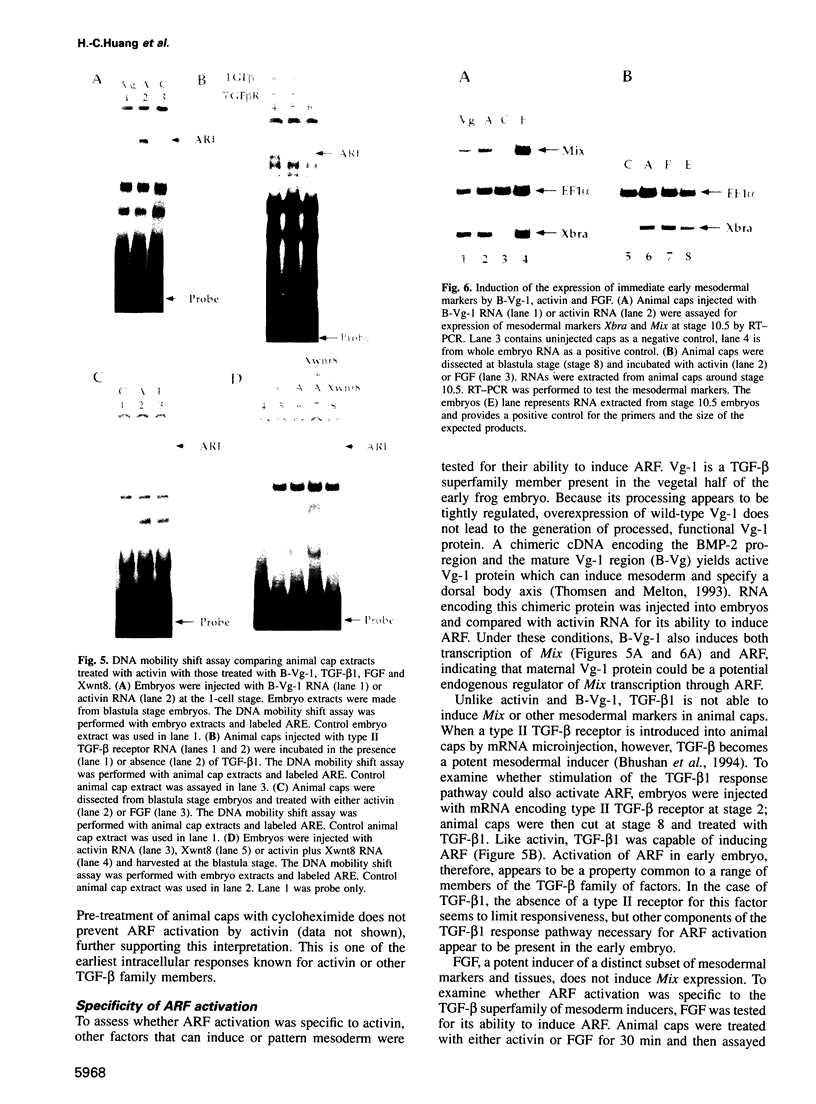
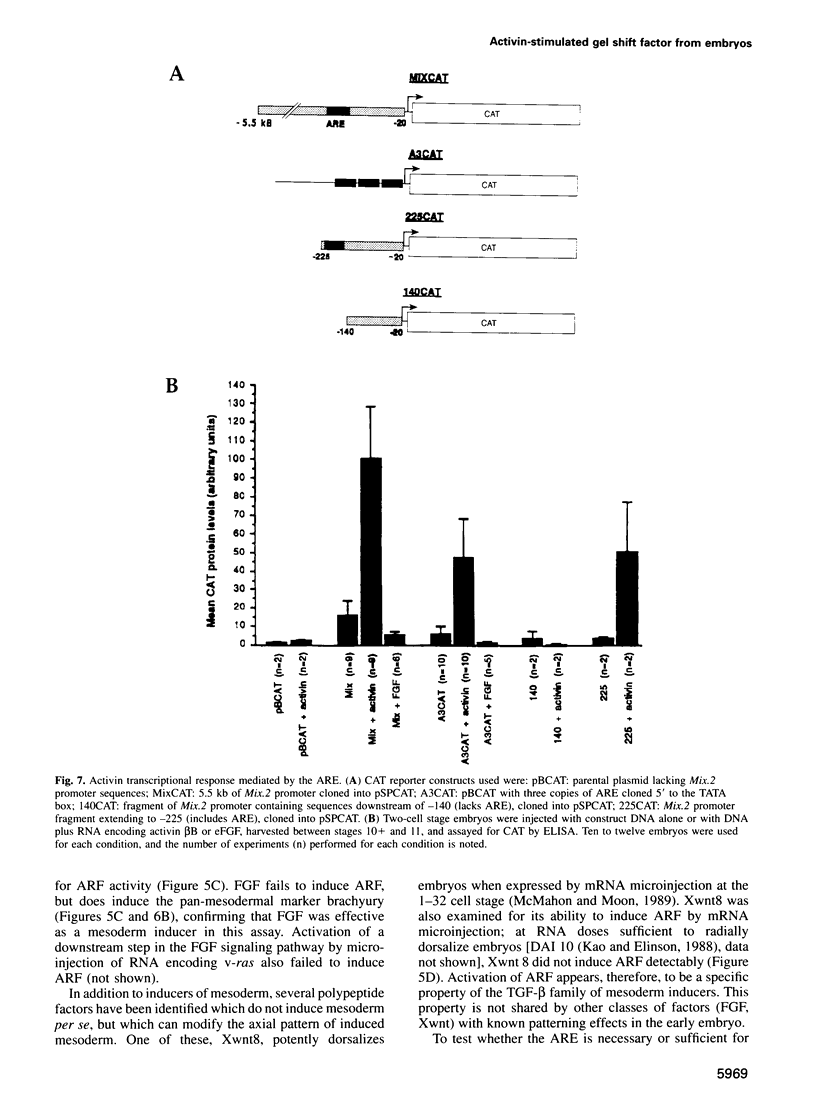
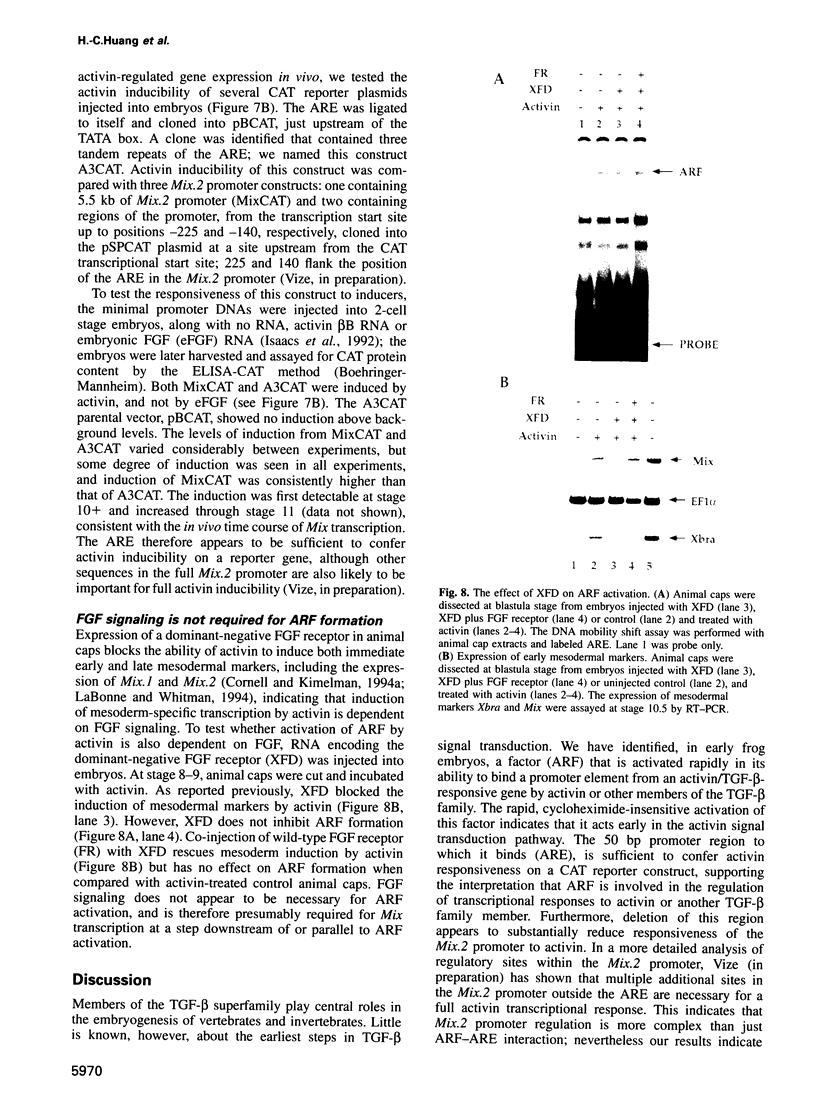
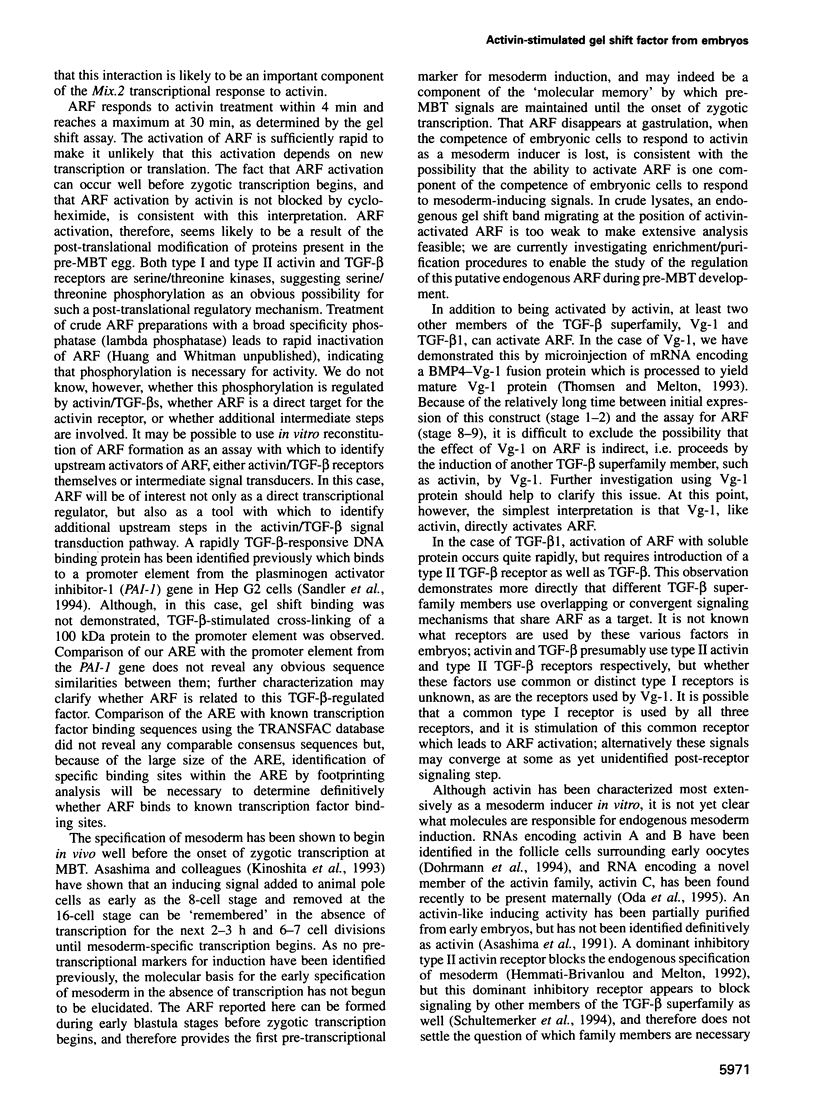
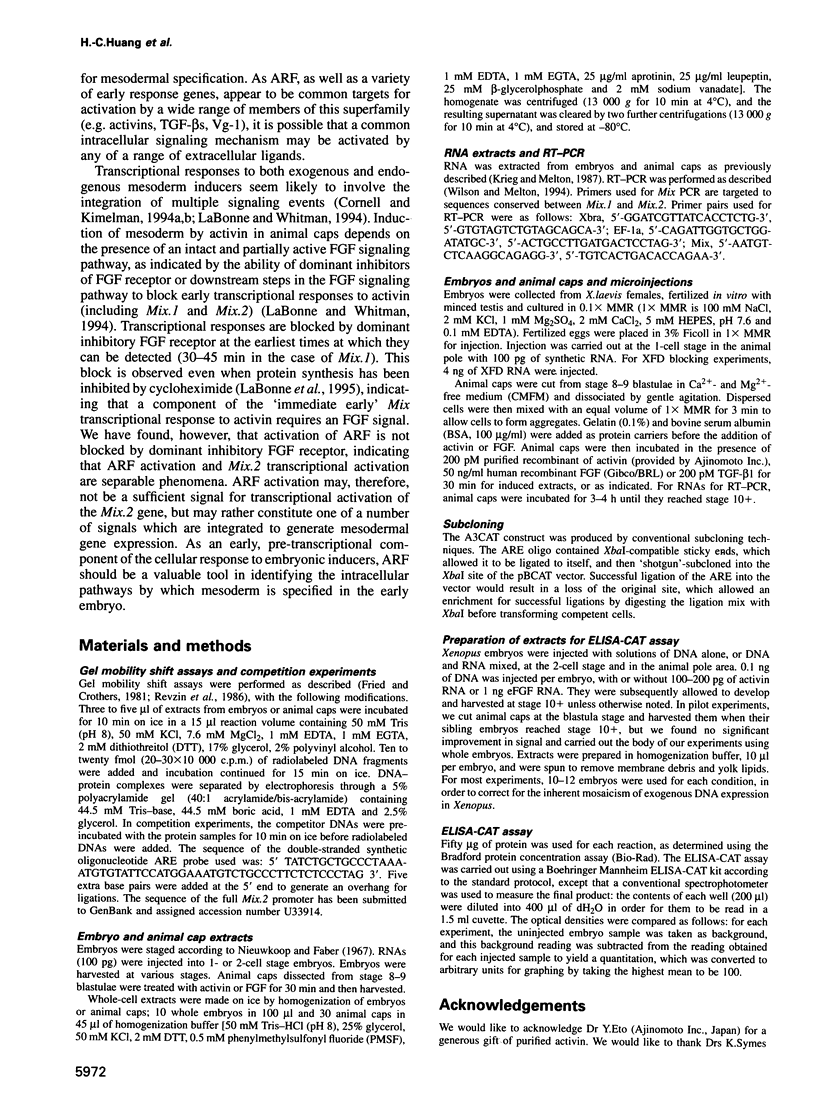
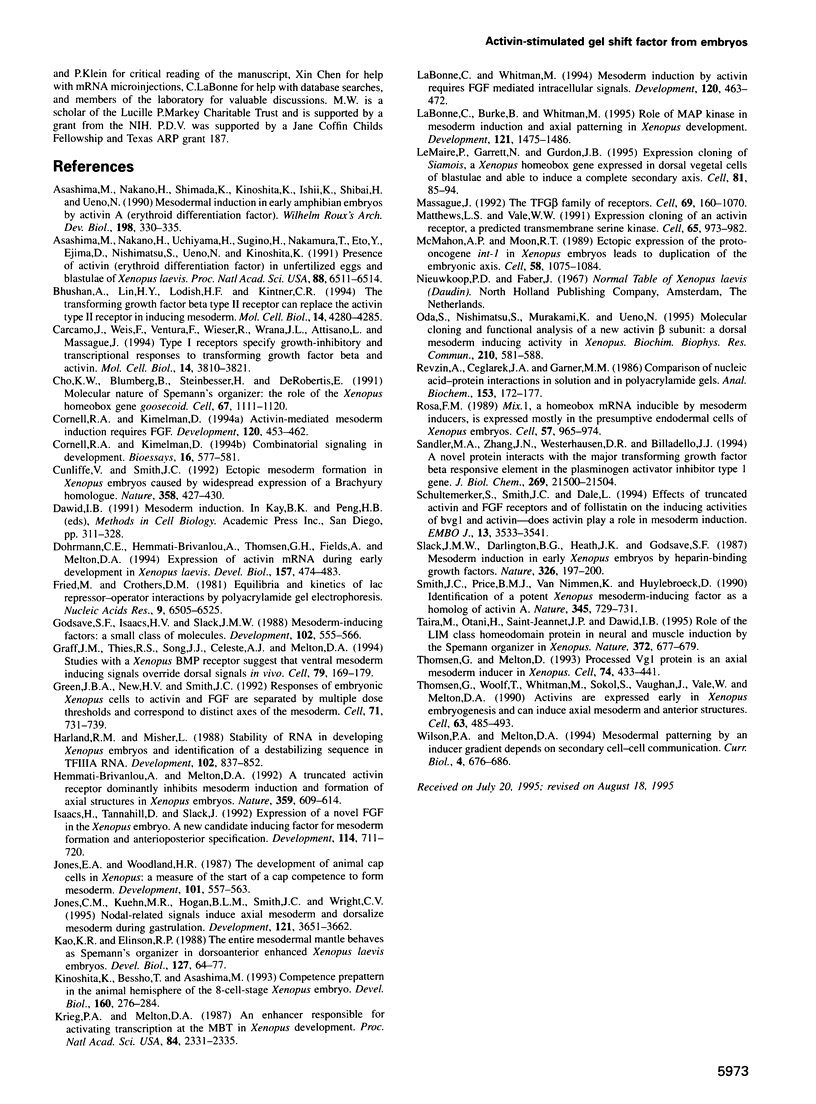
Images in this article
Selected References
These references are in PubMed. This may not be the complete list of references from this article.
- Asashima M., Nakano H., Uchiyama H., Sugino H., Nakamura T., Eto Y., Ejima D., Nishimatsu S., Ueno N., Kinoshita K. Presence of activin (erythroid differentiation factor) in unfertilized eggs and blastulae of Xenopus laevis. Proc Natl Acad Sci U S A. 1991 Aug 1;88(15):6511–6514. doi: 10.1073/pnas.88.15.6511. [DOI] [PMC free article] [PubMed] [Google Scholar]
- Bhushan A., Lin H. Y., Lodish H. F., Kintner C. R. The transforming growth factor beta type II receptor can replace the activin type II receptor in inducing mesoderm. Mol Cell Biol. 1994 Jun;14(6):4280–4285. doi: 10.1128/mcb.14.6.4280. [DOI] [PMC free article] [PubMed] [Google Scholar]
- Cho K. W., Blumberg B., Steinbeisser H., De Robertis E. M. Molecular nature of Spemann's organizer: the role of the Xenopus homeobox gene goosecoid. Cell. 1991 Dec 20;67(6):1111–1120. doi: 10.1016/0092-8674(91)90288-a. [DOI] [PMC free article] [PubMed] [Google Scholar]
- Cornell R. A., Kimelman D. Activin-mediated mesoderm induction requires FGF. Development. 1994 Feb;120(2):453–462. doi: 10.1242/dev.120.2.453. [DOI] [PubMed] [Google Scholar]
- Cornell R. A., Kimelman D. Combinatorial signaling in development. Bioessays. 1994 Aug;16(8):577–581. doi: 10.1002/bies.950160811. [DOI] [PubMed] [Google Scholar]
- Cunliffe V., Smith J. C. Ectopic mesoderm formation in Xenopus embryos caused by widespread expression of a Brachyury homologue. Nature. 1992 Jul 30;358(6385):427–430. doi: 10.1038/358427a0. [DOI] [PubMed] [Google Scholar]
- Cárcamo J., Weis F. M., Ventura F., Wieser R., Wrana J. L., Attisano L., Massagué J. Type I receptors specify growth-inhibitory and transcriptional responses to transforming growth factor beta and activin. Mol Cell Biol. 1994 Jun;14(6):3810–3821. doi: 10.1128/mcb.14.6.3810. [DOI] [PMC free article] [PubMed] [Google Scholar]
- Dawid I. B. Mesoderm induction. Methods Cell Biol. 1991;36:311–328. [PubMed] [Google Scholar]
- Dohrmann C. E., Hemmati-Brivanlou A., Thomsen G. H., Fields A., Woolf T. M., Melton D. A. Expression of activin mRNA during early development in Xenopus laevis. Dev Biol. 1993 Jun;157(2):474–483. doi: 10.1006/dbio.1993.1150. [DOI] [PubMed] [Google Scholar]
- Fried M., Crothers D. M. Equilibria and kinetics of lac repressor-operator interactions by polyacrylamide gel electrophoresis. Nucleic Acids Res. 1981 Dec 11;9(23):6505–6525. doi: 10.1093/nar/9.23.6505. [DOI] [PMC free article] [PubMed] [Google Scholar]
- Godsave S. F., Isaacs H. V., Slack J. M. Mesoderm-inducing factors: a small class of molecules. Development. 1988 Mar;102(3):555–566. doi: 10.1242/dev.102.3.555. [DOI] [PubMed] [Google Scholar]
- Graff J. M., Thies R. S., Song J. J., Celeste A. J., Melton D. A. Studies with a Xenopus BMP receptor suggest that ventral mesoderm-inducing signals override dorsal signals in vivo. Cell. 1994 Oct 7;79(1):169–179. doi: 10.1016/0092-8674(94)90409-x. [DOI] [PubMed] [Google Scholar]
- Green J. B., New H. V., Smith J. C. Responses of embryonic Xenopus cells to activin and FGF are separated by multiple dose thresholds and correspond to distinct axes of the mesoderm. Cell. 1992 Nov 27;71(5):731–739. doi: 10.1016/0092-8674(92)90550-v. [DOI] [PubMed] [Google Scholar]
- Harland R., Misher L. Stability of RNA in developing Xenopus embryos and identification of a destabilizing sequence in TFIIIA messenger RNA. Development. 1988 Apr;102(4):837–852. doi: 10.1242/dev.102.4.837. [DOI] [PubMed] [Google Scholar]
- Hemmati-Brivanlou A., Melton D. A. A truncated activin receptor inhibits mesoderm induction and formation of axial structures in Xenopus embryos. Nature. 1992 Oct 15;359(6396):609–614. doi: 10.1038/359609a0. [DOI] [PubMed] [Google Scholar]
- Isaacs H. V., Tannahill D., Slack J. M. Expression of a novel FGF in the Xenopus embryo. A new candidate inducing factor for mesoderm formation and anteroposterior specification. Development. 1992 Mar;114(3):711–720. doi: 10.1242/dev.114.3.711. [DOI] [PubMed] [Google Scholar]
- Jones C. M., Kuehn M. R., Hogan B. L., Smith J. C., Wright C. V. Nodal-related signals induce axial mesoderm and dorsalize mesoderm during gastrulation. Development. 1995 Nov;121(11):3651–3662. doi: 10.1242/dev.121.11.3651. [DOI] [PubMed] [Google Scholar]
- Kao K. R., Elinson R. P. The entire mesodermal mantle behaves as Spemann's organizer in dorsoanterior enhanced Xenopus laevis embryos. Dev Biol. 1988 May;127(1):64–77. doi: 10.1016/0012-1606(88)90189-3. [DOI] [PubMed] [Google Scholar]
- Kinoshita K., Bessho T., Asashima M. Competence prepattern in the animal hemisphere of the 8-cell-stage Xenopus embryo. Dev Biol. 1993 Nov;160(1):276–284. doi: 10.1006/dbio.1993.1305. [DOI] [PubMed] [Google Scholar]
- Krieg P. A., Melton D. A. An enhancer responsible for activating transcription at the midblastula transition in Xenopus development. Proc Natl Acad Sci U S A. 1987 Apr;84(8):2331–2335. doi: 10.1073/pnas.84.8.2331. [DOI] [PMC free article] [PubMed] [Google Scholar]
- LaBonne C., Burke B., Whitman M. Role of MAP kinase in mesoderm induction and axial patterning during Xenopus development. Development. 1995 May;121(5):1475–1486. doi: 10.1242/dev.121.5.1475. [DOI] [PubMed] [Google Scholar]
- LaBonne C., Whitman M. Mesoderm induction by activin requires FGF-mediated intracellular signals. Development. 1994 Feb;120(2):463–472. doi: 10.1242/dev.120.2.463. [DOI] [PubMed] [Google Scholar]
- Lemaire P., Garrett N., Gurdon J. B. Expression cloning of Siamois, a Xenopus homeobox gene expressed in dorsal-vegetal cells of blastulae and able to induce a complete secondary axis. Cell. 1995 Apr 7;81(1):85–94. doi: 10.1016/0092-8674(95)90373-9. [DOI] [PubMed] [Google Scholar]
- Massagué J. Receptors for the TGF-beta family. Cell. 1992 Jun 26;69(7):1067–1070. doi: 10.1016/0092-8674(92)90627-o. [DOI] [PubMed] [Google Scholar]
- Mathews L. S., Vale W. W. Expression cloning of an activin receptor, a predicted transmembrane serine kinase. Cell. 1991 Jun 14;65(6):973–982. doi: 10.1016/0092-8674(91)90549-e. [DOI] [PubMed] [Google Scholar]
- McMahon A. P., Moon R. T. Ectopic expression of the proto-oncogene int-1 in Xenopus embryos leads to duplication of the embryonic axis. Cell. 1989 Sep 22;58(6):1075–1084. doi: 10.1016/0092-8674(89)90506-0. [DOI] [PubMed] [Google Scholar]
- Oda S., Nishimatsu S., Murakami K., Ueno N. Molecular cloning and functional analysis of a new activin beta subunit: a dorsal mesoderm-inducing activity in Xenopus. Biochem Biophys Res Commun. 1995 May 16;210(2):581–588. doi: 10.1006/bbrc.1995.1699. [DOI] [PubMed] [Google Scholar]
- Revzin A., Ceglarek J. A., Garner M. M. Comparison of nucleic acid-protein interactions in solution and in polyacrylamide gels. Anal Biochem. 1986 Feb 15;153(1):172–177. doi: 10.1016/0003-2697(86)90077-1. [DOI] [PubMed] [Google Scholar]
- Rosa F. M. Mix.1, a homeobox mRNA inducible by mesoderm inducers, is expressed mostly in the presumptive endodermal cells of Xenopus embryos. Cell. 1989 Jun 16;57(6):965–974. doi: 10.1016/0092-8674(89)90335-8. [DOI] [PubMed] [Google Scholar]
- Sandler M. A., Zhang J. N., Westerhausen D. R., Jr, Billadello J. J. A novel protein interacts with the major transforming growth factor-beta responsive element in the plasminogen activator inhibitor type-1 gene. J Biol Chem. 1994 Aug 26;269(34):21500–21504. [PubMed] [Google Scholar]
- Schulte-Merker S., Smith J. C., Dale L. Effects of truncated activin and FGF receptors and of follistatin on the inducing activities of BVg1 and activin: does activin play a role in mesoderm induction? EMBO J. 1994 Aug 1;13(15):3533–3541. doi: 10.1002/j.1460-2075.1994.tb06660.x. [DOI] [PMC free article] [PubMed] [Google Scholar]
- Slack J. M., Darlington B. G., Heath J. K., Godsave S. F. Mesoderm induction in early Xenopus embryos by heparin-binding growth factors. Nature. 1987 Mar 12;326(6109):197–200. doi: 10.1038/326197a0. [DOI] [PubMed] [Google Scholar]
- Smith J. C., Price B. M., Van Nimmen K., Huylebroeck D. Identification of a potent Xenopus mesoderm-inducing factor as a homologue of activin A. Nature. 1990 Jun 21;345(6277):729–731. doi: 10.1038/345729a0. [DOI] [PubMed] [Google Scholar]
- Taira M., Otani H., Saint-Jeannet J. P., Dawid I. B. Role of the LIM class homeodomain protein Xlim-1 in neural and muscle induction by the Spemann organizer in Xenopus. Nature. 1994 Dec 15;372(6507):677–679. doi: 10.1038/372677a0. [DOI] [PubMed] [Google Scholar]
- Thomsen G. H., Melton D. A. Processed Vg1 protein is an axial mesoderm inducer in Xenopus. Cell. 1993 Aug 13;74(3):433–441. doi: 10.1016/0092-8674(93)80045-g. [DOI] [PubMed] [Google Scholar]
- Thomsen G., Woolf T., Whitman M., Sokol S., Vaughan J., Vale W., Melton D. A. Activins are expressed early in Xenopus embryogenesis and can induce axial mesoderm and anterior structures. Cell. 1990 Nov 2;63(3):485–493. doi: 10.1016/0092-8674(90)90445-k. [DOI] [PubMed] [Google Scholar]
- Wilson P. A., Melton D. A. Mesodermal patterning by an inducer gradient depends on secondary cell-cell communication. Curr Biol. 1994 Aug 1;4(8):676–686. doi: 10.1016/s0960-9822(00)00152-4. [DOI] [PubMed] [Google Scholar]









